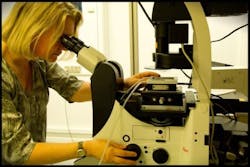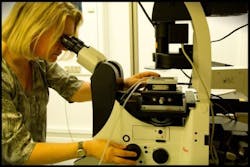Optical microscopy technique discovers that cell division induces tissue ordering
Using an optical microscopy technique, a team of researchers at the Niels Bohr Institute (Copenhagen, Denmark) has investigated the dynamics of new cell formation in a layer of endothelial cells where there was no liquid flowing over. The investigations took place in a laboratory system that mimiced the conditions in an endothelial cell layer where a blood clot blocks the blood flow.
"If, for example, there is a blood clot blocking the flow of blood across the innermost layer of the endothelial cells, they begin to actively divide. But what happens in the tissue? How do the newly formed cells move in relation to each other—and which mechanisms control their movements? This is what we wanted to investigate," explains biophysicist Lene Oddershede, head of the Optical Tweezers research group at the Niels Bohr Institute.
To follow the movement of the cells and the dynamics of the tissue "live," they used phase-contrast microscopy, which makes it possible to follow the movements in the tissue before, during, and after cell division. The new cells move away from each other and create a dynamic movement with eddies in a large area. This presumably helps to widen the vessel around the blockage.
"Our experimental studies showed that the tissue behaved like a viscous material. The endothelial cell layer is contiguous and the cells are in close contact with each other. When a cell has divided, the new cells move away from the point of origin and all the other cells follow this movement, which creates large, ordered, and far-reaching eddies in the tissue," says Oddershede.
Oddershede explains that well-ordered, far-reaching vortices are often a sign of turbulence, which is a normal phenomenon for fast movements in a flowing material with low viscosity like water, just like you also see in the characteristic turbulence patterns with 'eddies' in, for example, weather satellite images of cloud formations. The big surprise with the tissue dynamics was that the researchers found these characteristic turbulence patterns with 'eddies,' even though it was unexpected in such a slow and viscous system.
The research group has further supplemented the groundbreaking experimental results with theoretical modelling of the system and the modeling came up with the same results, providing a basic physical understanding of such a complex system as a blood vessel with a clot.
"This is a strong result that both the experimental results and simulations say that increased cell division may help tissue to grow and heal in a beneficial way and that this process is based exclusively on a physically dependent diffusion, requiring no biological signaling. This may be important for healing around blood clots is the swirling of a fluid and the reverse current created when the fluid flows pand it is an example of nature's ingenious ability to take care of itself," explains Oddershede.
Full results of the work appear in the journal Nature Communications; for more information, please visit http://dx.doi.org/10.1038/ncomms6720.
-----
Follow us on Twitter, 'like' us on Facebook, connect with us on Google+, and join our group on LinkedIn
Subscribe now to BioOptics World magazine; it's free!


